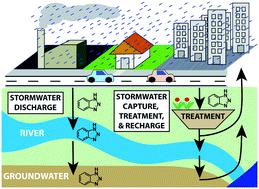当前位置:
X-MOL 学术
›
Environ. Sci.: Water Res. Technol.
›
论文详情
Our official English website, www.x-mol.net, welcomes your
feedback! (Note: you will need to create a separate account there.)
Hydrophilic trace organic contaminants in urban stormwater: occurrence, toxicological relevance, and the need to enhance green stormwater infrastructure
Environmental Science: Water Research & Technology ( IF 3.5 ) Pub Date : 2019-11-22 , DOI: 10.1039/c9ew00674e Stephanie Spahr 1, 2, 3, 3, 4 , Marc Teixidó 1, 3, 4, 5, 6 , David L. Sedlak 1, 3, 4, 5, 6 , Richard G. Luthy 1, 2, 3, 3, 4
Environmental Science: Water Research & Technology ( IF 3.5 ) Pub Date : 2019-11-22 , DOI: 10.1039/c9ew00674e Stephanie Spahr 1, 2, 3, 3, 4 , Marc Teixidó 1, 3, 4, 5, 6 , David L. Sedlak 1, 3, 4, 5, 6 , Richard G. Luthy 1, 2, 3, 3, 4
Affiliation

|
Hydrophilic trace organic contaminants (hyphil-TrOCs) are polar, often ionizable organic compounds of anthropogenic origin that have various applications in the urban environment e.g., as pesticides, plasticizers, and flame retardants. Hyphil-TrOCs can be washed off in storm events and enter surface waters via untreated urban stormwater discharges or combined sewer overflows. Though trace concentrations of these chemicals may pose a risk to ecosystem and human health, information on their presence in urban stormwater remains elusive. Monitoring and source apportionment of hyphil-TrOCs in urban stormwater is complicated by the vast number and sources of organic contaminants and the high variability in aqueous concentration over time and space. Here, we present the current state of knowledge on the occurrence and toxicological relevance of hyphil-TrOCs in urban stormwater. To mitigate negative impacts of contaminated surface runoff to receiving water bodies and to prevent sanitary or combined sewer overflows, many cities implement sustainable green stormwater infrastructure, also called best management practices (BMPs). Current knowledge suggests that conventional stormwater BMPs such as detention basins, constructed wetlands, and biofilters often fail to remove hyphil-TrOCs. We identify future research needs to enhance green stormwater infrastructure with respect to water quality and safe use of urban stormwater for non-potable applications or groundwater recharge and present potential benefits of geomedia amendments in BMPs (e.g., activated carbon or biochar-amended biofilters). We highlight the need to improve stormwater monitoring strategies by combining chemical and bioanalytical tools to better assess effects of complex chemical mixtures and the treatment performance of BMPs and assure safe stormwater use for water supply.
中文翻译:

城市雨水中的亲水性痕量有机污染物:发生,毒理学意义以及增强绿色雨水基础设施的需求
亲水性痕量有机污染物(hyphil-TrOCs)是人为来源的极性,通常可电离的有机化合物,在城市环境中有多种应用,例如农药,增塑剂和阻燃剂。Hyphil-TrOCs可以在暴风雨中冲刷掉,并通过以下途径进入地表水域:未经处理的城市雨水排放或下水道溢流。尽管这些化学品的痕量浓度可能对生态系统和人类健康构成威胁,但有关它们在城市雨水中的存在的信息仍然难以捉摸。由于大量的有机污染物和来源以及水浓度随时间和空间的高度变化,城市雨水中的亲水性-TrOCs的监测和来源分配变得复杂。在这里,我们介绍有关在城市雨水中Hyphil-TrOCs的发生和毒理学相关性的当前知识状态。为了减轻受污染的地表径流对接收水体的不利影响并防止卫生或下水道溢流,许多城市实施了可持续的绿色雨水基础设施,也称为最佳管理规范(BMP)。当前的知识表明,常规的雨水BMP(例如滞留池,人工湿地和生物滤池)通常无法去除hyphil-TrOCs。我们确定了未来的研究需求,以在水质和安全用于非饮用水应用或地下水补给的城市雨水方面加强绿色雨水基础设施,并提出了BMP中地基介质修订案的潜在好处(例如,活性炭或生物炭改性的生物滤池)。我们强调需要通过结合化学和生物分析工具来改善雨水监测策略,以更好地评估复杂化学混合物的效果和BMP的处理性能,并确保安全使用雨水来供水。
更新日期:2019-11-22
中文翻译:

城市雨水中的亲水性痕量有机污染物:发生,毒理学意义以及增强绿色雨水基础设施的需求
亲水性痕量有机污染物(hyphil-TrOCs)是人为来源的极性,通常可电离的有机化合物,在城市环境中有多种应用,例如农药,增塑剂和阻燃剂。Hyphil-TrOCs可以在暴风雨中冲刷掉,并通过以下途径进入地表水域:未经处理的城市雨水排放或下水道溢流。尽管这些化学品的痕量浓度可能对生态系统和人类健康构成威胁,但有关它们在城市雨水中的存在的信息仍然难以捉摸。由于大量的有机污染物和来源以及水浓度随时间和空间的高度变化,城市雨水中的亲水性-TrOCs的监测和来源分配变得复杂。在这里,我们介绍有关在城市雨水中Hyphil-TrOCs的发生和毒理学相关性的当前知识状态。为了减轻受污染的地表径流对接收水体的不利影响并防止卫生或下水道溢流,许多城市实施了可持续的绿色雨水基础设施,也称为最佳管理规范(BMP)。当前的知识表明,常规的雨水BMP(例如滞留池,人工湿地和生物滤池)通常无法去除hyphil-TrOCs。我们确定了未来的研究需求,以在水质和安全用于非饮用水应用或地下水补给的城市雨水方面加强绿色雨水基础设施,并提出了BMP中地基介质修订案的潜在好处(例如,活性炭或生物炭改性的生物滤池)。我们强调需要通过结合化学和生物分析工具来改善雨水监测策略,以更好地评估复杂化学混合物的效果和BMP的处理性能,并确保安全使用雨水来供水。











































 京公网安备 11010802027423号
京公网安备 11010802027423号